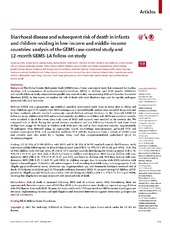| dc.Published | Levine MM, Nasrin D, Acácio S, Bassat Q, Powell, Tennant SM, et al. Diarrhoeal disease and subsequent risk of death in infants and children residing in low-income and middle-income countries: analysis of the GEMS case-control study and 12-month GEMS-1A follow-on study. The Lancet Global Health. 2020;8(2):e204-e214 | eng |
| dc.description.abstract | Background: The Global Enteric Multicenter Study (GEMS) was a 3-year case-control study that measured the burden, aetiology, and consequences of moderate-to-severe diarrhoea (MSD) in children aged 0–59 months. GEMS-1A, a 12-month follow-on study, comprised two parallel case-control studies, one assessing MSD and the other less-severe diarrhoea (LSD). In this report, we analyse the risk of death with each diarrhoea type and the specific pathogens associated with fatal outcomes. Methods: GEMS was a prospective, age-stratified, matched case-control study done at seven sites in Africa and Asia. Children aged 0–59 months with MSD seeking care at sentinel health centres were recruited along with one to three randomly selected matched community control children without diarrhoea. In the 12-month GEMS-1A follow-on study, children with LSD and matched controls, in addition to children with MSD and matched controls, were recruited at six of the seven sites; only cases of MSD and controls were enrolled at the seventh site. We compared risk of death during the period between enrolment and one follow-up household visit done about 60 days later (range 50–90 days) in children with MSD and LSD and in their respective controls. Approximately 50 pathogens were detected using, as appropriate, classic bacteriology, immunoassays, gel-based PCR and reverse transcriptase PCR, and quantitative real-time PCR (qPCR). Specimens from a subset of GEMS cases and controls were also tested by a TaqMan Array Card that compartmentalised probe-based qPCR for 32 enteropathogens. Findings: 223 (2·0%) of 11 108 children with MSD and 43 (0·3%) of 16 369 matched controls died between study enrolment and the follow-up visit at about 60 days (hazard ratio [HR] 8·16, 95% CI 5·69–11·68, p<0·0001). 12 (0·4%) of 2962 children with LSD and seven (0·2%) of 4074 matched controls died during the follow-up period (HR 2·78, 95% CI 0·95–8·11, p=0·061). Risk of death was lower in children with dysenteric MSD than in children with non-dysenteric MSD (HR 0·20, 95% CI 0·05–0·87, p=0·032), and lower in children with LSD than in those with non-dysenteric MSD (HR 0·29, 0·14–0·59, p=0·0006). In children younger than 24 months with MSD, infection with typical enteropathogenic Escherichia coli, enterotoxigenic E coli encoding heat-stable toxin, enteroaggregative E coli, Shigella spp (non-dysentery cases), Aeromonas spp, Cryptosporidium spp, and Entamoeba histolytica increased risk of death. Of 61 deaths in children aged 12–59 months with non-dysenteric MSD, 31 occurred among 942 children qPCR-positive for Shigella spp and 30 deaths occurred in 1384 qPCR-negative children (HR 2·2, 95% CI 1·2–3·9, p=0·0090), showing that Shigella was strongly associated with increased risk of death. Interpretation: Risk of death is increased following MSD and, to a lesser extent, LSD. Considering there are approximately three times more cases of LSD than MSD in the population, more deaths are expected among children with LSD than in those with MSD. Because the major attributable LSD-associated and MSD-associated pathogens are the same, implementing vaccines and rapid diagnosis and treatment interventions against these major pathogens are rational investments. | en_US |

